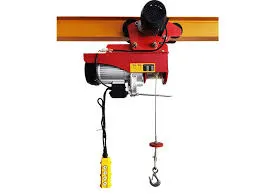


Understanding Small Hoist Trolleys Essential Tools for Lifting and Moving Loads
Small hoist trolleys are invaluable tools used in various industries for lifting and moving loads safely and efficiently. These compact devices are designed to facilitate the movement of heavy items along overhead tracks, making them essential for warehouses, construction sites, manufacturing plants, and even in residential settings. This article explores the functionality, benefits, and applications of small hoist trolleys.
What is a Small Hoist Trolley?
A small hoist trolley consists of a hoist mechanism that allows for vertical lifting, combined with a trolley that moves horizontally along tracks. The hoist is typically powered either manually or electrically, depending on its design and application. When paired with tracks or beams, these trolleys enable the swift relocation of heavy objects with minimal effort, ensuring greater safety and productivity.
Functionality
The primary function of a small hoist trolley is to hoist and transport loads. Users attach a load to the hoisting mechanism, which employs chains, cables, or straps to secure the item. The hoist can then raise the load to the desired height. Once elevated, the trolley can be maneuvered along the track, allowing for easy transportation to different locations.
This dual-functionality is particularly advantageous in tight spaces where maneuverability is crucial. Instead of needing a fork-lift or large machinery, a small hoist trolley can operate in confined areas, making it an efficient solution for moving items in warehouses or other industrial environments.
Benefits of Small Hoist Trolleys
1. Increased Safety Small hoist trolleys significantly reduce the risk of injury associated with manual lifting. By utilizing mechanized lifting, workers can avoid the strains and injuries that often come from handling heavy loads.

2. Efficiency and Productivity These trolleys allow for faster movement of materials. In industrial settings, this translates into improved workflows and reduced downtime, ultimately leading to enhanced productivity.
3. Space-Saving Design The compact nature of small hoist trolleys means they can fit into smaller spaces without sacrificing lifting capability. This is particularly beneficial in urban or smaller industrial environments where every square foot counts.
4. Versatility Small hoist trolleys can be used in various applications, including construction, automotive repairs, and DIY projects at home. Their adaptability makes them a useful addition to any toolkit.
5. Cost-Effective Investing in a small hoist trolley can lead to significant savings. They can reduce labor costs, decrease the likelihood of injuries that might lead to compensation claims, and enhance the speed of operations, which can improve overall profitability.
Applications
Small hoist trolleys find applications across different sectors. In manufacturing, they help in moving components during assembly. In warehouses, they facilitate the movement of heavy pallets and goods. Construction sites benefit from their ability to lift and relocate materials while ensuring safety standards are maintained. Even in home workshops, they serve as an efficient means to move heavy tools or materials.
Conclusion
In summary, small hoist trolleys are essential tools that bridge efficiency, safety, and adaptability in various lifting and transporting tasks. Whether in an industrial environment or for personal use, understanding their functionality and benefits can enhance operational effectiveness and minimize risks. As industries continue to seek solutions for safer and more productive workflows, small hoist trolleys remain a key component in achieving these goals.



